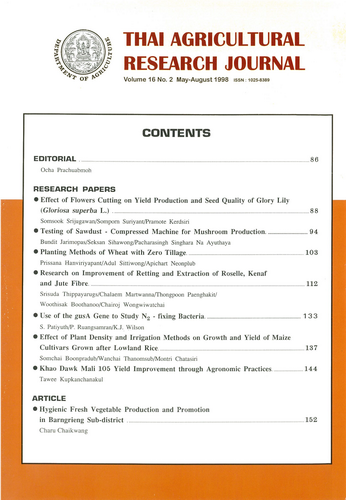Effect of Plant Density and Irrigation Methods on Grwoth and Yield of Maize Cultivars Grown after Lowland Rice
DOI:
https://doi.org/10.14456/thaidoa-agres.1998.13Keywords:
maize cultivar, plant density and irrigation methods, growth and yieldAbstract
The paddy field during dry season in one of the new land available to be promoted fro maize cultivation to replace a second ric ecrop due to less water consumption. However, their productivity is often limited by water management due to less suitable in plant density and irriagation methods. Field studies were conducted on clays soil at Phitsanulok Field Crops Experiment Station during 1994 and 1995 in dry seasom (January - May). The objectives of this study wee to determine the effect of the irrigation methods and plant densities on growth and grain yield of maize cultivars grown in paddy field under irrigated conditions. The results found that DK 888 in terms of hybrid cultivar produced approximately 65% higher grain yield than NS-1 as an open-pollinated cultivar. furrow irrigation method gave 11% higher grain yield than flooding irrigation, however, single and couble row were not significant. Moreover, increasing plant density from 8,553 to 12,800 plants/interaction between cultivars, irrigation and plant density methods in yield was also not significantly difference. Plant height, yield components and total dry matter were affected by maize cultivars, irrigation and plant density methods, however, their interactions were not significant by difference.
Downloads
Published
How to Cite
Issue
Section
License

This work is licensed under a Creative Commons Attribution-NonCommercial-NoDerivatives 4.0 International License.
Thai Agricultural Research Journal



